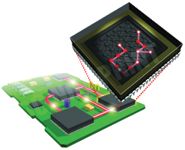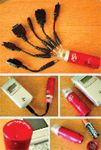New Technologies
Lasers that can produce coherent infrared light in the 1–2 ?m wavelength range are essential in telecommunications, biomedical diagnosis and optical sensing.
Paint-on laser
Lasers that can produce coherent infrared light in the 1–2 μm wavelength range are essential in telecommunications, biomedical diagnosis and optical sensing. Such small lasers could provide new smaller sensitive detectors for chromatography.
This may now be possible as Ted Sargent (University of Toronto, Toronto, Canada) has created a new laser using colloidal quantum dots — nanometre-sized particles of semiconductor that are suspended in a solvent similar to particles in paint.
This laser could help keep feeding the information-hungry Internet generation. The laser's most remarkable feature is its simplicity. Dipping a miniature glass tube into the paint and then drying it with a hairdryer can make a laser. Once the right nanoparticles are made, the procedure takes about five minutes.

Image credit: TrevorJohnston.com University of Toronto
The microchip industry is looking for components that exist on the scale of transistors and are made of semiconductors, which would produce light when exposed to electrical current. With this development, it could be possible to use the electronics already found on microchips to power a laser that communicates within the chip itself.
Don't run out of charge
You are away from your lab talking about some important results on your mobile when the battery runs out. Now try and find a payphone. Today maybe the only one you can find is the Police telephone box in the popular TV series, Dr Who.

But a new device, Charge 2 Go, has come to the rescue. The device uses one AA battery to provide up to two hours of talk time on most mobile telephones.
Charge 2 Go offers connectors for phones by Motorola, Nokia, Samsung, Siemens and Sony-Ericsson.
Insert an AA battery and connect the device to your mobile. A red light-emitting diode flashes, indicating that it is charging. A chip inside the Charge 2 Go converts a 1.5 V alkaline battery into a 3.7 V, 380 mA current for your mobile.
Charge 2 Go relies on AA batteries, which are available worldwide or small enough to carry as a spare, so this battery problem should be solved.
So the next time you travel you can even leave the bulky charger at home as this device easily fits into your pocket.
Now let's tackle the other problem of the batteries in my portable PC running out. Well I understand the company is looking into this and expects to be able to offer a device for iPods, and other hand-held devices soon.

Determining Enhanced Sensitivity to Odors due to Anxiety-Associated Chemosignals with GC
May 8th 2025Based on their hypothesis that smelling anxiety chemosignals can, like visual anxiety induction, lead to an increase in odor sensitivity, a joint study between the University of Erlangen-Nuremberg (Erlangen, Germany) and the Fraunhofer Institute for Process Engineering and Packaging (Freising, Germany) combined behavioral experiments, odor profile analysis by a trained panel, and instrumental analysis of odorants (gas chromatography-olfactometry) and volatiles (gas chromatography-mass spectrometry).
Investigating 3D-Printable Stationary Phases in Liquid Chromatography
May 7th 20253D printing technology has potential in chromatography, but a major challenge is developing materials with both high porosity and robust mechanical properties. Recently, scientists compared the separation performances of eight different 3D printable stationary phases.
Detecting Hyper-Fast Chromatographic Peaks Using Ion Mobility Spectrometry
May 6th 2025Ion mobility spectrometers can detect trace compounds quickly, though they can face various issues with detecting certain peaks. University of Hannover scientists created a new system for resolving hyper-fast gas chromatography (GC) peaks.

.png&w=3840&q=75)

.png&w=3840&q=75)



.png&w=3840&q=75)



.png&w=3840&q=75)










